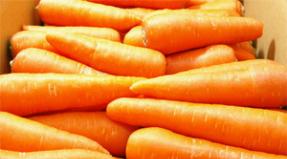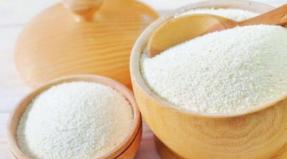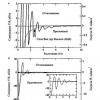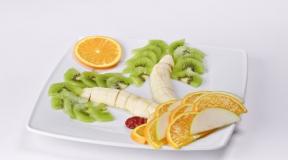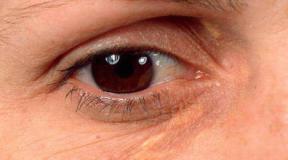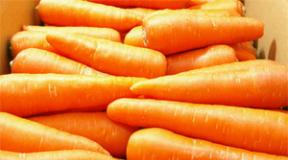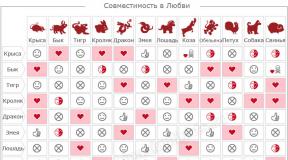Natural milk or powdered milk? Composition of milk powder. How to dilute powdered milk and what can be prepared from it
Milk is one of the most important food products. Nature works in such a way that from the first day of life, newborn children and young mammals feed only on mother’s milk. It contains all the necessary substances for the normal functioning of the growing organism. But even as a person grows older, he or she does not give up milk. We use it both in its natural form and in processed form (ryazhenka, yogurt, cream, sour cream, cottage cheese, butter). There is whole and skim milk, steamed and baked, condensed and... dry. And if everything is more or less clear with fermented milk products, then the last two arouse keen interest, especially among children. Surely the little fidget pestered you with the question: “What is milk made from?” In this article we will try to find the answer and learn a lot about a product we have known since childhood.
What is real milk made from?
Of course, if you think about it, the question “what is milk made from” seems stupid. But it only seems so. Of course, we are not talking about natural products. Another thing is store-bought milk. What is it made of? You can hear a similar question from the lips of a city kid quite often, and there is no reason to be surprised. Essentially, this is the same cow's milk, it just goes through processing before it gets to our table. Some unscrupulous manufacturers may dilute it with water or add vegetable fats to increase its fat content. But this is extremely rare. Most milk is made from natural raw materials.
Compound
It should be noted that people are accustomed to eating not only cow's milk - in some regions it is obtained from female deer, goats, mares, buffaloes, and camels. The chemical composition of these products naturally differs. We will focus on cow meat, since this is what is most often present on our table. So, it contains approximately 85% water, 3% protein (it is called casein), milk fat - up to 4.5%, up to 5.5% milk sugar (lactose), as well as vitamins and minerals. In factories and dairies where milk is made (more precisely, processed), much attention is paid to fat content and protein content. With a high fat content of the original product, the yield of butter is higher, and protein is important in the production of cottage cheese and various cheeses.

How milk is made at the plant and dairy factories
You can always find milk on the shelves of numerous stores. But before it gets there, it goes through processing. It is needed to protect the product. Of course, the beneficial properties are lost, but some still remain. Let's consider these processes in order. Raw milk entering the plant is first cooled and then homogenized. Homogenization is necessary so that when pouring milk into bags, cream does not settle on the surface. Essentially, this is milk fat, which is broken into small balls in a homogenizer and distributed evenly throughout the entire mass of milk. This allows you to improve the taste of the original product and increases its digestibility. Next comes heat treatment (it is necessary to disinfect milk, since it can contain not only beneficial microorganisms, but also pathogenic ones) - this can be pasteurization, ultra-pasteurization or sterilization.

Types of heat treatment
The first method is considered the most common. It is the most gentle and allows you to preserve not only the taste and smell, but also the beneficial properties. In addition, after pasteurization, milk lasts longer than usual. In modern industry, ultra-pasteurization is increasingly being used. This method differs from the previous one in the use of ultra-high temperature. Of course, there are no beneficial properties left in it at all. Sterilization is also characterized by high temperature processing. This milk has the longest shelf life (up to 6 months or even up to a year). As a rule, after heat treatment, it is filled into polyethylene or plastic containers and sold through retail chains.
About powdered milk

In addition to regular milk, there is also powdered milk. Probably not each of us knows how powdered milk is made. This product first became known back in 1832, when the Russian chemist M. Dirchov founded its production. In fact, to the question: “What is powdered milk made from?” The answer is simple: from natural cow meat. The process consists of 2 stages. At the first stage, the milk is condensed in high-pressure machines. Next, the resulting mixture is dried in special devices. As a result, a white powder remains - this is powdered milk, or rather its dry residue, which has lost 85% of its volume (water). The only advantage of such a product over whole milk is the possibility of its long-term storage. Plus, it takes up little space, which is very important when transporting. The composition of powdered milk is the same as that of whole milk, it just does not contain water. What powdered milk is made from is now clear. Let's move on to the scope of its application.

Where is milk powder used?
We have found out how powdered milk is made, now we will look at where it is used. Most often it is common in those regions where it is not possible to obtain a whole natural product. The powder is simply dissolved in warm water (in a ratio of 1 to 3), and then used for its intended purpose. Powdered milk is also the basis for the production of baby food (dry milk porridge) and feed for small calves. The product can be found on the open market.
About baked milk
There is another type of this indispensable product for humans - baked milk. Many of us are probably interested in how baked milk is made. Its difference from whole is the pronounced taste of pasteurization and the presence of a creamy tint. The process presents the following picture: whole milk is mixed with cream until the mass fraction of fat in the raw material is 4 or 6% (this process is called normalization). Then the mixture is subjected to homogenization (this process is mentioned above) and pasteurization with long-term aging (about 4 hours at a temperature of 95-99 ºC). In this case, the raw material is periodically mixed so that a film of proteins and fat does not form on its surface. It is prolonged exposure to temperature that contributes to the appearance of a creamy color (milk sugar actively interacts with amino acids, resulting in the formation of melanoidin, which gives this shade). The final stage is cooling and pouring baked milk into containers. That's all the wisdom. It should also be noted that baked milk (this is what people call this type of milk) is used to produce fermented baked milk and katyk (in their preparation, various starters are used, which results in a fermented milk product with a thick consistency and taste of baked milk).

About skim milk
Very often in the dairy departments of stores you can find packaging labeled “Skinned milk.” What it is? Essentially, this is regular milk, just without fat, that is, without cream. As a rule, the percentage of fat here is no more than 0.5%. How is skim milk made? It is obtained by separating the whole product in special devices - separators. There the cream is separated from the milk under the influence of centrifugal forces. The result is a fat-free liquid.

Scope of application of skim milk
Milk packaging always indicates the exact amount of fat and protein in the product. It should be noted that it is impossible to obtain milk with a specific fat content from a cow. This indicator is not the same even for one cow in different seasons. Since GOSTs have their own standards and requirements, milk has to be standardized as skimmed in order to ultimately obtain the required fat content (2.5%, 3.2% or 6%). This milk is also used to produce low-fat kefir, cottage cheese or yogurt. You can buy it in packaged form at any store. It costs, of course, cheaper than usual.
We can talk about milk and its benefits endlessly. No wonder we have always been told since childhood: “Drink milk - it is very healthy.” And it’s true, our life begins with it - immediately after birth, the baby is necessarily put to the breast so that he receives the first portion of nutritious colostrum. Thanks to mother's milk, the child's immunity is strengthened, the baby grows and develops. The amazing thing is that in the first months of life it completely satisfies the child’s needs for water, nutrients, vitamins and minerals. Surely any of us has noticed that the basis of a healthy and proper diet is always dairy and fermented milk products. Cottage cheese is very useful for growing children; it contains a lot of calcium, which is necessary for the growth of bones and healthy teeth. Doctors also recommend that older people include milk in their diet, since bones rapidly lose calcium during this period of life. Whatever one may say, this product is irreplaceable. In this article we looked at what milk is made from, what types of milk exist and how it is useful. Surely you have learned a lot of new and interesting things for yourself. Be healthy!
Previously, powdered milk was widely used in home cooking, in baby food, and in the preparation of coffee drinks. Now this product is undeservedly forgotten. The production of this product is all the more attractive for entrepreneurs due to the lack of competition in the market.
Composition of milk powder
Today there are three types of milk on the market: whole, skim and instant. They differ primarily in fat content and, accordingly, energy value. Whole milk powder contains 25% fat. And a completely different matter is skimmed milk powder, the composition of which includes only 1% fat. The energy value of the first is 549 kcal, and the second is 373 kcal. It would be wrong to think that powdered milk is a useless substitute. Powdered milk contains calcium, sodium, potassium, phosphorus, about 20 amino acids and vitamins. Thus, milk powder has a very good composition. Proteins in it range from 26% in low-fat to 36% in whole.
Powdered milk market
Recently, milk powder has practically disappeared from sale and has become a real shortage. But there is a demand for this product. This is an indispensable product in cooking, animal husbandry, and cosmetics production. In addition, there are regions where there are objective difficulties with fresh milk. Thus, this market is extremely far from saturation. Organizing the sale of finished products will not be difficult at all. Inexpensive low-fat milk is used as raw material.

Production premises and equipment
There are certain requirements for industrial premises of this type. These include the requirement for the availability of drinking water, heating, sewerage, and electricity. The room should also have a ventilation system, and the walls and floor should be covered with materials that are easy to clean.
Equipment for the production of milk powder is quite simple and consists of several parts:
- drying unit, which consists of a pump, drying chamber and air heater;
- storage bunker;
- line for sifting and packaging of finished products.
Powdered milk production technology
Milk heated to 40 degrees is first filtered to remove possible impurities - debris, sand, grass. The milk is then normalized using a separator, which separates the milk from the cream. This is done so that the powdered milk contains no more than the percentage of fat determined by the technology. Next, the mixture is subject to pasteurization. This is a mandatory step, it is necessary to destroy bacteria. The milk is then condensed in an evaporator. Then this mixture is homogenized, that is, it is given a uniform consistency. Only now the condensed homogeneous milk mass enters the drying chamber, from which it enters the bunker in the form of a dry powder.

Equipment price. Sales
A ready-made, established business can cost approximately 55 million rubles. Separately, equipment for the production of milk powder can be purchased for 10 million rubles.
Sales are carried out through retail chains, markets, directly to farms, confectionery shops, and baby food production plants.
It is better to locate production in a region where there is no shortage of raw materials. But on the contrary, it is better to sell the finished product where there is little fresh milk, or it is relatively expensive, or of poor quality, or poorly stored.
The benefits and harms of powdered milk
If we talk about a quality product, the benefits of powdered milk are almost the same as those of natural cow's milk. The nutritional value of the natural product is slightly higher. Both milks contain approximately the same amount of cholesterol. And, for example, milk powder contains more vitamin B12, which can be useful for some diseases, such as anemia. Powdered milk can harm the body only in case of individual intolerance to lactose, that is, milk sugar. Symptoms: bloating, pain, diarrhea. But the same symptoms can be observed if a low-quality product containing harmful deodorized milk fats comes to your table. It cannot be determined by appearance or smell. The consumer can only read the label and give preference to products from trusted manufacturers. It should be noted that natural milk, which is purchased in supermarkets, may be of poor quality and contain, for example, soy.

Before use, milk powder is diluted with clean warm water in a ratio of one to three. You can add sugar, honey, spices to taste. Confectionery and bread made with milk powder are especially tasty. In addition to eating, you can prepare homemade cosmetic masks and creams based on milk powder.
It is important to remember that powdered milk, although slower, also spoils. Therefore, it must be stored in the refrigerator, at a temperature from 0 to 10 degrees with a humidity not exceeding 85%. If these conditions are met, milk powder can be stored for up to eight months.
Milk is perhaps one of the healthiest and at the same time popular food products. It should be present in the diet of children and adults; it is consumed on its own and used to prepare a wide variety of dishes. However, ordinary pasteurized milk is not always convenient to use, so scientists many years ago began to create powdered milk. On this page www.site we will talk about what powdered milk is, the benefits and harms it can cause from consumption, and also answer the question of how milk is prepared from powdered milk.
About what powdered milk contains, what is its composition
Powdered milk is actually a simple concentrate made from regular pasteurized cow's milk. It is obtained by drying.
Now you can find whole, skim and instant milk on sale. Their main difference lies in the percentage of a number of substances, as well as in the field of application.
Composition of milk powder. Whole milk is a source of four percent moisture, twenty-six percent protein, twenty-five percent fat, thirty-seven percent lactose and ten percent minerals. As for skim milk, it contains five percent moisture, thirty-six percent protein, one percent fat, fifty-two percent milk sugar and six percent minerals.
One hundred grams of milk is a source of some vitamin A, vitamin E, D and PP, ascorbic acid and B vitamins (B1, B2, B9 and B12). This product also contains quite a lot of choline, calcium, sodium, potassium and phosphorus. In addition, milk powder contains small amounts of magnesium, cobalt, molybdenum, selenium, manganese, as well as iron, iodine, sulfur and chlorine. This product saturates the body with twenty essential amino acids.
Benefits of milk powder
Users most often think about the health benefits of powdered milk when they see it in the list of ingredients in various products. But numerous studies confirm that there are practically no differences between whole milk and a product reconstituted from dry powder. The beneficial qualities of powdered milk primarily lie in the fact that it is made from high-quality cow's milk. However, it is worth recognizing that natural cow's milk is characterized by greater nutritional value, which is explained by the high content of proteins, vitamin elements and carbohydrates. And in terms of cholesterol content, both of these products are almost equal.
Powdered milk is a source of significant amounts of vitamin B12, which makes this product especially useful for anemia. Just one hundred grams of reconstituted milk from such a powder can cover a person’s daily need for this vitamin.
A significant advantage of powdered milk is the fact that it does not require heat treatment (boiling), because it was properly processed directly during preparation. Such a product can be of great benefit to bodybuilders looking to gain muscle mass. They should drink two to three servings of this drink per day.
Thus, powdered milk is an excellent replacement for a fresh product. It perfectly saturates the body with energy and nutrients, is easily absorbed and does not burden the digestive tract. Reconstituted milk can be taken by patients with diabetes mellitus, as well as gastroenterological diseases.
The beneficial qualities of powdered milk are largely determined by its quality. Only a high-quality product can be used as a temporary replacement for natural cow's milk.
Is powdered milk dangerous? Is there any harm from it?
Powdered milk (as well as natural milk) can harm people whose bodies do not have a special substance - an enzyme for breaking down lactose. With such a pathology, taking milk powder can cause diarrhea, bloating and pain in the peritoneum. Such symptoms are a contraindication to its consumption.
Powdered milk can cause significant harm to humans if manufacturers do not comply with technological standards for the production of this drink. Thus, some manufacturers add not milk fat, but insufficiently high-quality deodorized vegetable fats, which deprive the final product of the most valuable fat-soluble vitamins. However, such a violation can only be detected in the laboratory. That is why, when choosing powdered milk, you should give preference to popular and proven brands.
It should be noted that whole milk contains a lot of fat. Accordingly, if you do not want to gain weight, do not abuse this drink.
In addition, the quality of milk powder largely depends on compliance with its storage conditions. Air humidity should not rise above 85%, and the optimal temperature is from 0 to 10C.
How to make milk from milk powder?
You can easily make milk from the dry powder. To do this, you just need to combine it with lukewarm, pre-boiled water, maintaining a ratio of 1:3. Combine water and powder gradually, stirring constantly. Next, leave the prepared drink for a while to infuse.
High-quality milk powder is an excellent temporary alternative to natural cow's milk. It is actively used in cooking, in the manufacture of baby food and in cosmetology.
Cow's milk is one of the first products that a newborn baby becomes familiar with. It is included in the consumer basket and is used not only in its pure form, but also for preparing a wide variety of dishes. Therefore, it is no coincidence that humanity was looking for ways to extend its shelf life and as a result, powdered milk appeared - an analogue of a liquid product. What are its benefits and harms to human health?
Composition of milk powder
If we are talking about a natural dry product made from fresh cow’s milk, then it will be practically no different from it. Of course, the extraction method changes its composition in some way, but it should not be considered some kind of chemical analogue that can cause harm to health.
Milk Powder: The production of this product involves thickening the contents of a cow's udder and then evaporating it. The higher the temperature is set during the last procedure, the less vitamins and nutrients will be in the final product. However, it is impossible to completely destroy them; some part will certainly remain.
What valuable components does milk powder contain that are valuable for the body? The composition of this product is enriched with proteins, amino acids and vitamins, among which are A, D, E, PP and group B.
As for the mineral components, exposure to high temperatures cannot in any way affect their numbers, so they are contained here in full, including calcium, potassium, phosphorus, magnesium, sodium, chlorine, sulfur and others. Whole milk powder has a calorie content of 549.3 kcal, and skimmed milk has a calorie content of 373 kcal. The dry analogue contains much fewer components that can cause allergies and provoke digestive upset.
Beneficial properties of milk powder
Actually, the benefits of powdered milk are beyond doubt: it has the same qualities as. First of all, its value lies in its ability to strengthen bones and teeth. It is an excellent prevention of osteoporosis.
Milk is often used to combat viral lung infections, since the immunoglobulins necessary for this are formed precisely from protein foods.
Athletes use powdered milk to build muscles by consuming special formulas based on it, and young mothers who, for some reason, cannot breastfeed their baby, buy infant formula, which again contains powdered milk.
Not everyone suffering from gastrointestinal diseases has the opportunity to drink fresh milk, but dry milk is absorbed better by the body, regulates the acidity of the stomach, eliminating pain, and normalizing intestinal function.
The low-fat product helps fight extra pounds, and is often included in masks, healing baths and other products for the beauty of skin, hair and nails.
Milk is good for the heart and blood vessels, it improves vision, prevents the appearance of wrinkles and sagging skin and has an antirachitic effect. Today it can be found in sausages and confectionery products, dairy products - cheese, cottage cheese, yogurt, sour cream and others.
Depending on the percentage of various substances in it, whole, skim and instant milk is distinguished, which is used in a variety of areas.
The harm of dry milk is identical to the harm of liquid milk. First of all, it is contraindicated for persons with lactose intolerance, in whose body there is no enzyme capable of break down lactose.
In addition, more and more people on the planet suffer from allergies to milk, for whom, for obvious reasons, it is also not recommended to take it.
Many people notice that after consuming this product they begin to suffer from bloating, diarrhea and other unpleasant consequences, but, as already mentioned, a dry product can minimize this effect.
In addition, older people should not get carried away with drinking milk, as there is a risk of developing atherosclerosis for those who have an excess of calcium salts in their joints.
Powdered milk: a substitute for a fresh product can be harmful if low-quality raw materials are used. Everything matters here: what the cows ate during milking, what were the conditions for storing the contents of their udder, and much more.
Milk is a healthy product, but it has one drawback - a short shelf life. They tried to extend it in ancient times. The first mention of powdered milk dates back to the 13th century, when Genghis Khan’s warriors stored a valuable product in this way for long campaigns. In Russia, the first commercial enterprise for the production of milk powder appeared in 1832, and at the end of the 19th century the product was patented and its industrial production began. Today, milk powder is used in cooking, for making infant formula, in bodybuilding for gaining muscle mass and in diets for weight loss.
Composition and benefits of milk powder
Does dry milk differ from fresh milk in its composition? This is the first question consumers ask themselves. It's different, but only slightly.
In the process of obtaining the powder, whole milk is subjected to heat treatment, so some of the vitamins in it are destroyed. The mineral and protein composition remains unchanged.
Table: composition of whole milk powder 25% fat (per 100 g)
| Useful material | Quantity |
| Vitamins | |
| Vitamin A | 147 mcg |
| Retinol | 0.13 mg |
| Vitamin B1 | 0.27 mg |
| Vitamin B2 | 1.3 mg |
| Vitamin B4 | 81 mg |
| Vitamin B5 | 2.7 mg |
| Vitamin B6 | 0.2 mg |
| Vitamin B9 | 30 mcg |
| Vitamin B12 | 3 mcg |
| Vitamin C | 4 mg |
| Vitamin D | 0.25 mcg |
| Vitamin E | 0.4 mg |
| Vitamin H | 10 mcg |
| Vitamin RR, NE | 6.1 mg |
| Macronutrients | |
| Potassium | 1200 mg |
| Calcium | 1000 mg |
| Magnesium | 119 mg |
| Sodium | 400 mg |
| Sulfur | 260 mg |
| Phosphorus | 790 mg |
| Chlorine | 820 mg |
| Microelements | |
| Aluminum | 50 mcg |
| Iron | 0.5 mg |
| Iodine | 50 mcg |
| Cobalt | 7 mcg |
| Manganese | 0.05 mg |
| Copper | 121 mcg |
| Molybdenum | 36 mcg |
| Tin | 13 mcg |
| Selenium | 12 mcg |
| Strontium | 17 mcg |
| Fluorine | 110 mcg |
| Chromium | 17 mcg |
| Zinc | 3.42 mg |
| Digestible carbohydrates | |
| Mono- and disaccharides (sugars) | 39.3 g |
| Lactose | 37.5 g |
| The nutritional value | |
| Calorie content | 483 kcal |
| Squirrels | 26 g |
| Fats | 25 g |
| Carbohydrates | 39.3 g |
| Organic acids | 1.2 g |
| Water | 4 g |
| Ash | 6.3 g |
Proteins are represented by 18 amino acids, including 10 essential ones. Fats include saturated (14.9%), mono- and polyunsaturated fatty acids. The amount of cholesterol is 90 mg per 100 g of milk powder.
Beneficial features
Reconstituted milk is recommended for dietary nutrition for diseases of the digestive system. The mineral complex strengthens bone tissue, blood vessels and heart muscle. It contains less sugars, so it is useful for people suffering from diabetes. Due to the fact that reconstituted milk powder is easier to digest than raw milk, it is used in infant formula for artificial feeding.
100 g of milk powder contains the daily requirement of vitamin B12, so it is recommended to drink reconstituted milk for anemia associated with a deficiency of this vitamin.
Types of milk powder
Today, three types of milk powder are produced - whole, skim and instant. Whole and skim milk is obtained by evaporation. Skim milk powder contains 25 times less fat than whole milk. Thanks to this, its shelf life is much longer.
Instant milk is produced using a technology slightly different from the traditional method - using freeze-drying with mixing two types of milk - whole and skim.
Photo gallery: types of milk powder
Contraindications and possible harm
- Powdered milk has the same contraindications for consumption as raw milk:
- individual intolerance and allergy to milk sugar (lactose).
Possible harm from excessive consumption of dry milk can be caused by oxysterol, which is present in it in much greater quantities than in raw milk. Oxysterol is oxidized cholesterol, which is found in all products of animal origin. Its amount increases during heat treatment of food or during long-term storage. Oxysterol can harm the cardiovascular system and cause atherosclerosis.
Skim milk powder contains the smallest amount of oxidized cholesterol, so it is preferable for older people to consume it.
Daily intake of powdered milk
Despite the heated debate among nutritionists about the benefits and harms of cow's milk for an adult body, people continue to consume their favorite product. Official medicine has established the following daily norms:
- children from 1 to 3 years old - 400 – 600 ml;
- children over 3 years old and adults - from 600 ml to 1 liter.
One liter of reconstituted milk contains a daily dose of calcium. This means that its use is not just useful, but necessary for older people to prevent osteoporosis.
For older people, it is better to slightly reduce the daily intake, since the activity of the lactase enzyme decreases with age.
These standards include the total amount of milk - both that which is drunk and that which is used for preparing cereals and other dishes. Do not overuse dry milk and drink it every day.
Nuances of use
Despite the almost complete similarity in the compositions of fresh and powdered milk, the latter has some nuances and restrictions for consumption.
Powdered milk and bodybuilding
- More recently, before the advent of special sports nutrition, bodybuilders used milk powder as a source of protein. In fact, modern protein mixtures and milk powder differ in composition. Without delving into the specifics of the issue, we can say that you can use milk powder to build muscle mass, but in limited quantities:
- for men - 1 – 1.25 servings per day (1 serving = 100 g);
women - 0.5 – 0.75 servings.
These are the norms for whole milk powder. If the milk is skim, then the portions should be doubled.
Milk is a necessary product during pregnancy and breastfeeding. It is a source of minerals that a woman needs to maintain her own health and appearance. To minimize the intake of synthetic vitamin preparations, doctors have developed special mixtures for pregnant and nursing mothers based on skim milk powder. The mixtures are enriched with all the necessary vitamins and minerals. These include milkshakes Femilak and Nutrimil.
Reconstituted milk is good for pregnant women and nursing mothers to drink
For women who are allergic to lactose, the solution is skim milk powder, which contains minimal milk sugar. Moreover, modern manufacturers produce milk with already fermented lactose, which makes it completely safe for allergy sufferers. Information about this is always present on the packaging. Nursing mothers can drink it without fear from the first days of a child’s life.
To protect yourself from low-quality or counterfeit products, you should buy milk powder manufactured in accordance with GOST 33629–2015 or 52791–2007.
Powdered milk in baby food
As complementary food for up to a year, doctors recommend giving the child not ordinary pasteurized milk, but dry milk. It can be used in pure form or in ready-made milk formula. Regular raw milk can be introduced into a child’s diet only after one year of age. Up to one year, a child should receive an adapted dairy product in the amount of 1 liter per day. If your baby enjoys drinking reconstituted milk, there is no need to replace it with regular pasteurized milk. Here's what Dr. E.O. Komarovsky says about this.
When to switch from powdered milk to pasteurized milk? The smartest thing to do is never. Powdered milk is sterile, cheap, easier to digest, less likely to cause allergies, and more convenient to store.
Why, after all, are almost all children switched to pasteurized milk? Usually because the mother wants it that way. She herself does not like the taste of powdered milk, and therefore, when a child drinks less milk than usual, the mother thinks that he no longer likes powdered milk and switches him to fresh milk. In addition, mothers usually view this transition as another achievement for the child. No one has yet proven that children prefer fresh milk to dry milk, but I have rarely been able to convince mothers of this. From a medical point of view, there is no need to switch from powdered milk to fresh milk.Dr. Komarovsky E.O.
http://lib.komarovskiy.net/izmeneniya-v-pitanii-i-rezhime.html
For pancreatitis
If there is no allergy to milk, patients with pancreatitis are recommended to consume it during the period of remission. The daily intake of milk for drinking is no more than 100 ml. You can cook porridge and dietary soups using reconstituted milk.
For diseases of the pancreas, only milk powder is allowed. The natural product should be excluded from the diet.
For kidney diseases
Milk and its derivatives are contraindicated for urolithiasis. However, the restriction applies only to stones of phosphate origin. The composition of the stones is determined through analysis.
Kidney disease is not a contraindication or restriction in the use of powdered milk. Moreover, based on it, there are therapeutic diets and traditional medicine recipes to relieve inflammation.
For weight loss
Skimmed milk powder is suitable for weight loss as part of a dairy diet. Its advantage is that it is a complete protein product with low fat content. Any diet reduces the dietary intake of essential vitamins and minerals. Powdered milk during weight loss is an excellent source of vital nutrients.
Useful recipes of traditional medicine
Powdered milk is not only a food product. It is used in traditional medicine recipes for preparing medicinal mixtures.
Milk with carrot juice
2 tablespoons of carrot juice (freshly squeezed) are combined with a glass of warm reconstituted milk. The mixture is taken twice a day before meals. It is a diuretic and is used for urolithiasis.
Pine milk
Powdered milk is diluted in 500 ml of water according to the instructions on the package. 50 g of pine buds are added to it. The broth is cooked over low heat for 20 minutes. You need to drink it in small sips throughout the day. For children, the volume is halved. Helps with dry cough - thins and removes mucus. Has an antipyretic effect.
Milk and honey to cleanse the liver
Powdered milk is no less beneficial for the liver than regular pasteurized milk. It can be used to clean the organ. It is carried out as part of complex therapy and against the background of a special diet. The recipe is simple - in the morning on an empty stomach you need to drink a glass of reconstituted milk with a dessert spoon of honey. It is better to use skim milk powder. You should not eat anything for 4 hours after taking it. The course is designed for 1 month, then a break of 10 days is required. You should consult your doctor about the advisability of a repeat course.
Photo gallery: ingredients for medicinal recipes based on milk powder
Freshly squeezed carrot juice is very healthy. Pine buds can be purchased at the pharmacy. Honey is a storehouse of nutrients.
Answers to the most frequently asked questions about milk powder
Consumers most often have the following questions:
- Are there many chemical additives in milk powder? Properly produced milk powder does not contain any “chemicals”. This is a completely natural, but only dehydrated product.
- Is it possible to eat powdered milk? You can eat powdered milk with spoons, but you need to take into account that in this case a large amount of milk sugar - lactose - enters the body. But it definitely won’t bring benefits in concentrated form. Therefore, it is better to dilute milk powder with water.
- Does milk powder contain harmful substances? If it is made from high-quality raw materials, it does not contain. But cows that have received low-quality feed can produce milk with harmful impurities. Then the milk powder will contain harmful substances.
- Is it necessary to boil diluted milk powder? Reconstituted milk does not require boiling, as it has already undergone heat treatment during the production process.
Use of milk powder in cosmetics
Masks and other milk-based care products have been used since ancient times. In beauty recipes, you can replace regular milk with powdered milk.
Face masks
Recipe 1. A mask with dry milk, oatmeal and green tea will refresh your face.
For it you will need:
- 40 g milk powder,
- 20 g dry chopped oat flakes,
- 3 – 4 tablespoons of strongly brewed green tea.
Dry ingredients are poured into tea and mixed thoroughly. The composition is applied to the face for 15 - 20 minutes.
Recipe 2. You can whiten your skin using a mask of milk powder, kefir and lemon juice.
Ingredients:
Kefir will moisturize the skinLemon juice will whiten your skin
Hair care
For hair care, it is better to use whole milk powder due to its higher fat content.
A yeast mask with milk will help strengthen your hair and stimulate its growth. In 6 tablespoons of reconstituted warm milk, dilute 2 tablespoons of dry yeast. After 15 minutes, add a tablespoon of honey. The composition is applied to the hair along the entire length for 45 minutes, then washed off with water.

